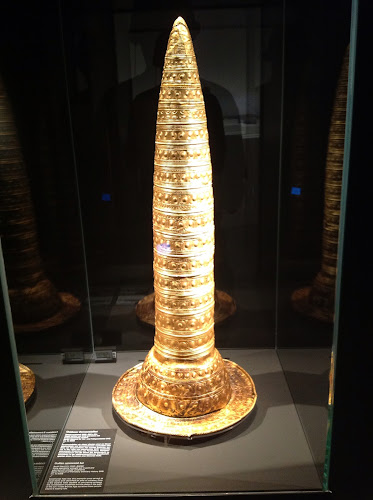But scroll down! There's more!
Very close to the Marienkirch is Neptune's Fountain and the Berlin City Hall. Both were beautiful, but I unfortunately don't know much history or information behind either. Considering the amount of tourists around me, I don't think I was the only one who was just snapping pictures for the sake of the photos. Oh well. I hope you enjoy the pictures nonetheless.
About a ten to twenty minute walk away was the "Museum-Insel," which is home to five museums: Altes-Museum (pictured immediately below), Alte National-galerie, Neues Museum, Pergamon Museum, and the Bode Museum. Close by also is the DDR (GDR) Museum. A gypsy approached me in front of the Altes Museum, and she asked me to read a card in English. I started reading haltingly, "I from Romania" before I realized who she was, quickly ending with, "Nein!" She promptly left, looking for other American targets. Later a boy waved a piece of paper at me, saying, "Read!" but he got a quicker "Nein!" from me.
I spent about four hours in the Pergamon Museum, which I think was a good amount of time to digest the many artifacts and rooms housing material from classical antiquity. The most impressive is the Pergamon Altar. Perhaps included in the temple to Zeus, it is just an altar, though a very impressive one. Some speculate that it may not have been included in a temple at all, since the backside of it features the most impressive statues. These statues running around the base tell the story of Hercules' son, Telephus, who founded the city of Pergamon and, as myth states, is also the ancestor of Romulus, the founder of Rome. Thus this altar served also as an anti-Roman message, celebrating the very ancestor of the Romans. This altar was only one of three such worship sites in Pergamon. The other two I believe were dedicated to Athena, one or both of which had some pillars removed and taken to Berlin. It was a very impressive room whose pillars dwarfed the Altar itself.
A decapitated Zeus
You can see more pictures from the Peramon altar and Athena room in the album above. I don't have room for them here.
After that I went through the special exhibit, which consisted of a presentation of what we know about early humans and what they thought and knew. Getting past the evolutionary bias, it was interesting; there were a number well-thought out rooms, and some that didn't impress me at all. However, I didn't take many pictures; nothing really stuck out at me. I did recognize one artifact below, the Nebra Sky Disk, which is a map of the heavens on a bronze plate. You can probably find out more online. The other is a golden hat used for astronomical measurements.
Having left the special exhibit, I went through the Ishtar Gate, which was very impressive. The audio companion that I had said that the lions embossed along the wall would have impressed and filled with fear newcomers to the royal city. And I thought, "And not massive size of the walls?" To get a sense of the size, look at the animals on the wall- they're about 4-5' tall. Now compare the wall below with the smaller of the two walls in the second picture. Yeah. It was big.
After that came many statues and images from other time periods and places in the Middle East. While it was all very interesting, and I took many interesting pictures, I'm afraid you'll just have to look in the album. There were just too many time periods and kingdoms for me to keep straight in my head and to match up with the pictures.
After that I went to the Museum of Islamic Art, which was included in the same building as the Pergamon Museum. There were many beautiful carpets from antiquity, some of which had been partly torn or destroyed. The intricate architecture was beautiful, as you can see below. I enjoyed this small museum; it fit in well with the Pergamon Middle-Eastern section.
So that took about four hours to walk through, and I'm glad I wasn't rushed. It was wonderful to walk leisurely, taking photos and listening to the commentary. I will definitely have to visit the other museums another time. Below are some pictures I took coming out of the museum and walking around the Museum-island.






















No comments:
Post a Comment